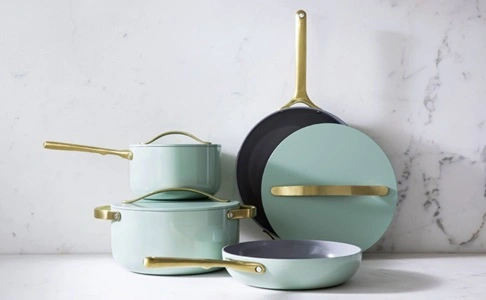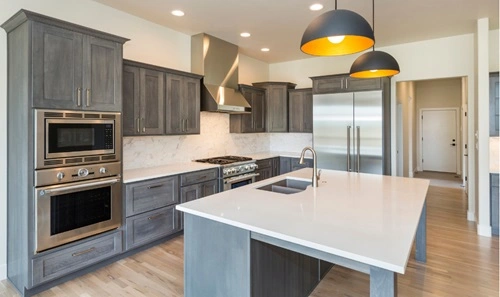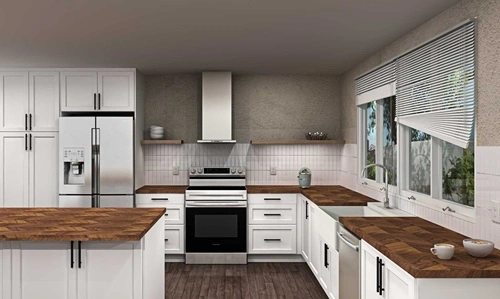In the world of cookware, ceramic pans have carved out a niche for themselves, offering a blend of aesthetic appeal, safety, and functionality. Touted as a healthier and eco-friendly alternative to traditional nonstick pans, ceramic cookware has gained popularity in recent years. However, like any kitchen tool, ceramic pans come with their own set of advantages and disadvantages.
This article provides an in-depth look at the pros and cons of ceramic pans, helping you decide if they deserve a spot in your kitchen.
What Are Ceramic Pans?

Ceramic pans are often mistaken as being made entirely of ceramic, but most are actually metal pans coated with a layer of ceramic. This ceramic coating is derived from silica, a natural material sourced from sand, which is then hardened and cured to create a smooth, nonstick surface. Unlike traditional nonstick pans that use polytetrafluoroethylene (PTFE) or perfluorooctanoic acid (PFOA), ceramic pans are free of these synthetic chemicals, making them a safer choice for health-conscious cooks.
The Pros of Ceramic Pans
1. Non-Toxic and Eco-Friendly
One of the most significant advantages of ceramic pans is their safety. They are free of PTFE, PFOA, lead, and cadmium, ensuring that no harmful chemicals leach into your food. Additionally, the manufacturing process for ceramic pans tends to be more environmentally friendly, producing fewer emissions than traditional nonstick cookware.
2. Nonstick Surface
Ceramic pans boast an excellent nonstick surface, allowing for cooking with little to no oil or butter. This makes them an ideal choice for health-conscious individuals looking to reduce fat in their meals. The nonstick surface also makes cleaning easier, as food residue typically slides off effortlessly.
3. Even Heat Distribution
Ceramic pans are known for their ability to distribute heat evenly across the cooking surface. This ensures consistent cooking, reducing the likelihood of hotspots that can burn food. Even heat distribution is particularly beneficial for delicate dishes like eggs, pancakes, and fish.
4. Aesthetic Appeal
Ceramic pans are available in a wide range of colors and designs, adding a touch of style to your kitchen. Their sleek and vibrant appearance makes them a favorite among those who value aesthetics in their cookware.
5. Scratch-Resistant (to an Extent)
While no cookware is entirely scratch-proof, ceramic pans are more resistant to scratches compared to traditional nonstick pans. When used with non-metal utensils, they maintain their smooth surface for a longer period.
6. Versatility
Ceramic pans are versatile and can be used on various heat sources, including gas, electric, and some induction stovetops. Many ceramic pans are also oven-safe, providing added flexibility for recipes that require stovetop-to-oven cooking.
7. Affordable Options
Ceramic pans are available in a wide price range, catering to different budgets. While premium brands can be pricey, many affordable options provide excellent performance and durability.
The Cons of Ceramic Pans
1. Durability Concerns
Despite their initial appeal, the nonstick coating on ceramic pans tends to wear off over time, especially with frequent use. This can lead to diminished performance, requiring replacement sooner than other types of cookware.
2. Sensitive to High Heat
Ceramic pans perform best at low to medium heat. High temperatures can cause the coating to degrade or discolor, reducing their lifespan. This limitation can be frustrating for those who prefer high-heat cooking methods like searing.
3. Prone to Chipping
While ceramic pans are relatively scratch-resistant, they are not immune to chipping or cracking if mishandled. Dropping a ceramic pan or using metal utensils can damage the coating, compromising its nonstick properties.
4. Requires Careful Maintenance
To prolong the life of a ceramic pan, special care is needed. Hand washing is often recommended, as dishwashers can be abrasive. Additionally, using non-metal utensils and avoiding abrasive cleaning pads are essential to prevent damage.
5. Shorter Lifespan Compared to Other Cookware
On average, ceramic pans last 1–3 years with regular use, which is shorter than the lifespan of traditional stainless steel or cast iron cookware. While they are affordable, the need for frequent replacement can offset the initial cost savings.
6. Not Fully Scratch-Proof
Although ceramic pans are advertised as scratch-resistant, improper use, such as cutting food directly in the pan or using metal utensils, can still result in scratches. Over time, these scratches can impact the pan’s nonstick performance.
7. Limited Heat Conductivity
Ceramic pans generally have a base made of aluminum or another metal, which provides decent heat conductivity. However, the ceramic coating itself is not as conductive as metals like copper or stainless steel, meaning the pan may take slightly longer to heat up.
8. Incompatibility with Certain Induction Cooktops
While some ceramic pans are induction-compatible, not all are. It’s important to check the manufacturer’s specifications to ensure compatibility with your induction stovetop.
Who Should Consider Ceramic Pans?
Ceramic pans are an excellent choice for individuals who:
- Prioritize health and safety in their cookware, avoiding harmful chemicals like PTFE and PFOA.
- Prefer low-fat cooking and easy cleanup due to the nonstick surface.
- Cook primarily at low to medium heat settings.
- Appreciate aesthetically pleasing cookware that complements their kitchen décor.
- Are willing to invest in proper care and maintenance to prolong the lifespan of their pans.
However, they may not be the best option for heavy-duty cooking, high-heat recipes, or those seeking cookware with a longer lifespan.
Tips for Maintaining Ceramic Pans
- Use Non-Metal Utensils: Stick to silicone, wooden, or plastic utensils to avoid scratching the nonstick coating.
- Avoid High Heat: Keep the pan at low to medium heat to preserve the integrity of the ceramic coating.
- Hand Wash Only: Use a soft sponge and mild detergent for cleaning. Avoid dishwashers and abrasive pads.
- Store Properly: Use pan protectors or store pans individually to prevent scratches or chipping.
- Preheat Gently: Avoid preheating an empty ceramic pan, as this can cause thermal shock and damage the coating.
Conclusion
Ceramic pans offer a compelling mix of health benefits, cooking performance, and aesthetic appeal, making them a popular choice for modern kitchens. Their non-toxic, eco-friendly properties and nonstick surface are significant advantages, especially for those who value health-conscious cooking. However, their relatively short lifespan, sensitivity to high heat, and maintenance requirements may be drawbacks for some users.
By understanding the pros and cons of ceramic pans and following proper care practices, you can maximize their performance and enjoy their benefits for years to come. Whether you’re a home cook looking for a safe and stylish option or someone exploring healthier cookware alternatives, ceramic pans can be a valuable addition to your kitchen arsenal.



